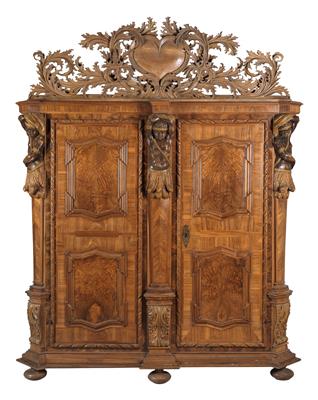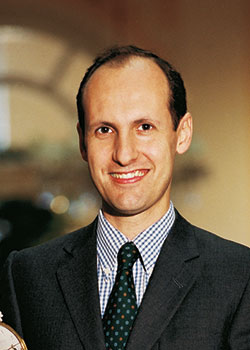An unusual Baroque hall cupboard,

18th century, probably a collaboration with the studio of the monastery of Heiligenkreuz (Giovanni Giuliani), demountable softwood frame with wedge joints, moulded cornice and base, canted angles, veneered in walnut and burl walnut, caryatids in the form of carved and painted black pages, 2 doors with panels, elaborately carved crest featuring a heart-shaped central field trimmed with acanthus leaves, blued and engraved iron bands, lock, c. 270 x 224 x 75 cm, some wood parts replaced, signs of age and use.
Giovanni Giuliani (Venice 1664 — 1744 Heiligenkreuz) trained in Venice and Bologna, and was a student of the court sculptor Andreas Faistenberger from 1680 to 1690. The native Venetian spent many years working as an independent artist in the service of the prominent Cistercian monastery of Heiligenkreuz in Lower Austria. From 1697 onwards, Giuliani received commissions from Prince Johann Adam Andreas of Lichtenstein. In 1700, the Prince was one of the most important noble patrons of the arts, and he had a preference for engaging distinguished Italian artists. From his earliest works onwards, Giuliani collaborated closely with Johann Bernhard Fischer von Erlach, and took Georg Raphael Donner as his apprentice in 1709/10. The collaboration and apprenticeship with these two prestigious Austrian Baroque artists emphasises Giuliani’s importance and significance, as does the impressive list of his aristocratic and clerical patrons.
Esperto: Alexander Doczy
 Alexander Doczy
Alexander Doczy
+43-1-515 60-302
alexander.doczy@dorotheum.at
10.05.2017 - 17:00
- Stima:
-
EUR 25.000,- a EUR 40.000,-
An unusual Baroque hall cupboard,
18th century, probably a collaboration with the studio of the monastery of Heiligenkreuz (Giovanni Giuliani), demountable softwood frame with wedge joints, moulded cornice and base, canted angles, veneered in walnut and burl walnut, caryatids in the form of carved and painted black pages, 2 doors with panels, elaborately carved crest featuring a heart-shaped central field trimmed with acanthus leaves, blued and engraved iron bands, lock, c. 270 x 224 x 75 cm, some wood parts replaced, signs of age and use.
Giovanni Giuliani (Venice 1664 — 1744 Heiligenkreuz) trained in Venice and Bologna, and was a student of the court sculptor Andreas Faistenberger from 1680 to 1690. The native Venetian spent many years working as an independent artist in the service of the prominent Cistercian monastery of Heiligenkreuz in Lower Austria. From 1697 onwards, Giuliani received commissions from Prince Johann Adam Andreas of Lichtenstein. In 1700, the Prince was one of the most important noble patrons of the arts, and he had a preference for engaging distinguished Italian artists. From his earliest works onwards, Giuliani collaborated closely with Johann Bernhard Fischer von Erlach, and took Georg Raphael Donner as his apprentice in 1709/10. The collaboration and apprenticeship with these two prestigious Austrian Baroque artists emphasises Giuliani’s importance and significance, as does the impressive list of his aristocratic and clerical patrons.
Esperto: Alexander Doczy
 Alexander Doczy
Alexander Doczy
+43-1-515 60-302
alexander.doczy@dorotheum.at
|
Hotline dell'acquirente
lun-ven: 09.00 - 18.00
kundendienst@dorotheum.at +43 1 515 60 200 |
| Asta: | Collezione Reinhold Hofstätter |
| Tipo d'asta: | Asta in sala |
| Data: | 10.05.2017 - 17:00 |
| Luogo dell'asta: | Wien | Palais Dorotheum |
| Esposizione: | 05.05. - 10.05.2017 |
